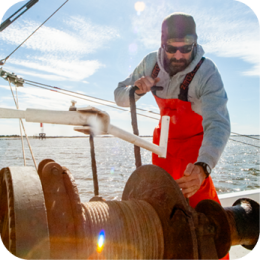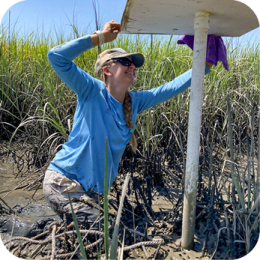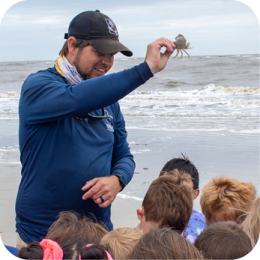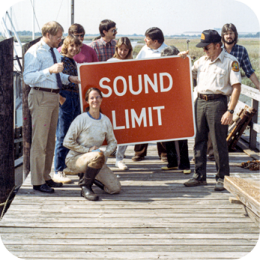

While it’s not hard to harvest these coastal Georgia delicacies, it helps to know where to start and what
kind of gear you need.
As the weather cools off and people start to gather in back yards for oyster roasts across the coast, we thought we’d offer some pro-tips for harvesting your own wild oysters. Dominic Guadagnoli is one of CRD’s longest-serving employees and the lead of the Shellfish and Water Quality Unit. He’s been harvesting oysters for much of his life and was kind enough to share some tricks.
Coastlines Magazine: What do I need to know before I get started harvesting oysters?
Dominic Guadagnoli: Harvesting wild oysters can be a fun way to enjoy some time outdoors and learn about where coastal Georgia seafood comes from. It’s always a way to connect with our coastal past, as people for thousands of years on the coast have harvested oysters as food. You don’t have to be a professional oyster picker to harvest your own oysters, but there are a few things you should know before hitting our estuaries and filling up your buckets. First of all, a recreational Georgia fishing license and free Saltwater Information Program (SIP) permit are needed for you to harvest oysters. If you don’t already have a fishing license and SIP permit, you can obtain one at GoOutdoorsGeorgia.com or at a variety of retailers throughout the state. Remember that oysters harvested with a recreational license cannot be sold, as with all other species harvested recreationally.
There is also a risk associated with consuming raw oysters, and people with compromised immune systems or other risk factors should weigh those risks before eating raw seafood of any kind.
CM: What kind of equipment is needed?
DG: Harvesting wild oysters is not hard, but it helps to have the right gear and equipment. First off, most recreational harvest areas are only accessible by boat. While it helps to have a powerboat, a seasoned kayaker can make it to most of the harvest areas, as long as they are going with the tide. You’ll want to harvest oysters at low tide, so be sure to check the tides before going out. You’ll need a basket or bucket to hold the oysters once you’ve picked them. Each recreational harvester is allowed to take two bushels of oysters per day, with a maximum of six bushels per boat.
As a good rule of thumb, a bushel of oysters will fill about two leveled-off five gallon buckets.
Because Georgia’s wild oysters are known to have sharp edges, you’ll want to bring some solid work gloves to protect your hands. I also recommend you wear some rubber boots with thick soles. Lastly, you’ll need a hard object to knock off dead or undersized shells. A crowbar or piece of heavy rebar will work just fine. It’s illegal to use anything except a handheld implement to harvest oysters.
CM: Where can oysters be harvested?
DG: It’s also very important to know where you can harvest oysters. CRD has designated certain area as recreational shellfish harvest areas. CRD’s Water Quality Unit regularly tests these areas for the presence of indicator bacteria. You can visit https://coastalgadnr.org/approvedrecharvestareas for maps of these areas and to learn more about harvesting oysters. Recreationally harvesting oysters outside of these areas is not only dangerous, it’s illegal.
CM: When is the best time to harvest oysters?
DG: Generally speaking, the season runs from Oct. 1 to the end of May. Check CoastalGaDNR.org for information about season openings and closures. Oyster season opens when water temperatures drop consistently below 81 degrees. This is to prevent the spread of bacteria-related illness. Remember that oyster can only be harvested half an hour before sunrise until half an hour after sunset according to Georgia law.
CM: What should I look for when picking oysters to harvest?
DG: A healthy oyster will close tightly when tapped. Oysters that do not respond to tapping are likely dead, and you don’t want to eat any kind of shellfish that’s dead. Oysters must be at least three inches from hinge to mouth to be harvestable. If smaller oysters are attached to a legal size one, they can be kept if separating the smaller one from the larger one is not possible. To separate oysters, hold them in the palm of your hand and knock them with the rebar or crowbar around the edges to get them to separate. Be careful not to damage the oysters, as best you can.
Once the oysters are harvested, it’s best to keep them on ice. If you cannot bring ice with you, make sure you get them into refrigeration within about two hours. This will significantly reduce the risk of food-borne illness.
CM: Why do wild oysters look different from the ones seen in most restaurants?
DG: Georgia’s wild oysters are the same species as the single-cup beauties you see in restaurants. What’s different is their environmental conditions. Because they are wild, the floating larva will attach to existing substrate. On our coast, that ideally is an existing oyster reef. Once an oyster sets on a spot, it will stay there for its entire life. That’s why we see clumpy masses of oyster reefs in our estuaries. They may not be as pretty as the restaurant oysters, but they’re just as delicious (if not more), and completely natural. Restaurant oysters are just fine, too, and the reason many are single-cup is the method they are reared in. A lot of single-cup oysters these days are spawned in artificial hatcheries and tricked into setting on a tiny grain of ground up oyster shell, so they never get the chance to set on other shells. This way, the grow up as singles instead of clusters like in the wild.
CM: How are oysters cooked?
DG: Some people eat oysters raw. Like mentioned before, that does pose a risk of food-borne illness, so be aware of that and weigh your individual risk. To shuck open an oyster, hold it in the palm of your hand and side the sharp end of an oyster knife into the hinge. Holding the oyster firmly in one hand, twist the knife with the other until the hinge pops open. From there, scrape loose the muscle connecting the oyster to the shell and enjoy.
Alternatively, some people like to steam oysters. You can do this in a steamer basket available at hardware stores or online, or you can go old-school and place a heavy metal plate over an open fire. Once the plate is hot, place them on the metal plate and cover them with a very wet burlap sack or towel you don’t mind ruining. You’ll know they are cooked when the shells begin to open. Even though the oysters are steamed, they can still pose a risk for food-borne illness. This is because the temperature required to eliminate the threat will turn the oyster into a raisin-sized, chewy nugget. Steaming oysters to the temperature most people like will still have some risk -- think of it as “medium rare.”
CM: What should I do with my shells afterwards?
DG: I’m so glad you asked! Once you’ve enjoyed all your oysters and you have a big, stinky pile of shells, you can get rid of them by donating them to CRD. We take these oyster shells and put them back in the estuaries where they can help recruit new oysters that enhance and restore existing reefs. Visit CoastalGaDNR.org/ShellRecycling for a map of where you can drop your shells off.







